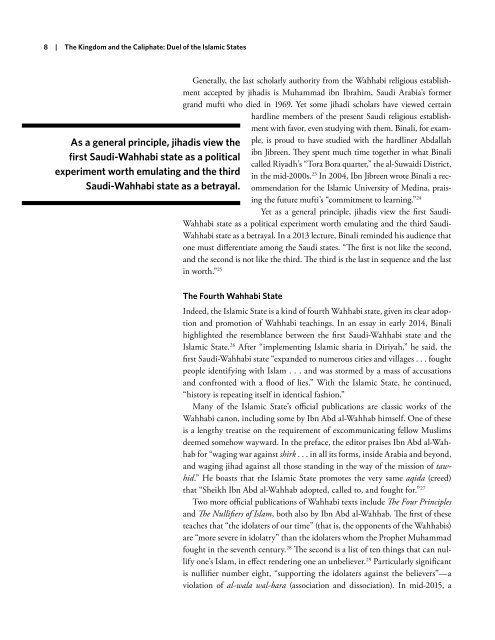Create successful ePaper yourself
Turn your PDF publications into a flip-book with our unique Google optimized e-Paper software.
8 | The Kingdom and the Caliphate: Duel of the Islamic States<br />
Generally, the last scholarly authority from the Wahhabi religious establishment<br />
accepted by jihadis is Muhammad ibn Ibrahim, Saudi Arabia’s former<br />
grand mufti who died in 1969. Yet some jihadi scholars have viewed certain<br />
hardline members of the present Saudi religious establishment<br />
with favor, even studying with them. Binali, for example,<br />
is proud to have studied with the hardliner Abdallah<br />
As a general principle, jihadis view the<br />
ibn Jibreen. They spent much time together in what Binali<br />
first Saudi-Wahhabi state as a political<br />
called Riyadh’s “Tora Bora quarter,” the al-Suwaidi District,<br />
experiment worth emulating and the third in the mid-2000s. 23 In 2004, Ibn Jibreen wrote Binali a recommendation<br />
for the Islamic University of Medina, prais-<br />
Saudi-Wahhabi state as a betrayal.<br />
ing the future mufti’s “commitment to learning.” 24<br />
Yet as a general principle, jihadis view the first Saudi-<br />
Wahhabi state as a political experiment worth emulating and the third Saudi-<br />
Wahhabi state as a betrayal. In a 2013 lecture, Binali reminded his audience that<br />
one must differentiate among the Saudi states. “The first is not like the second,<br />
and the second is not like the third. The third is the last in sequence and the last<br />
in worth.” 25<br />
The Fourth Wahhabi State<br />
Indeed, the Islamic State is a kind of fourth Wahhabi state, given its clear adoption<br />
and promotion of Wahhabi teachings. In an essay in early 2014, Binali<br />
highlighted the resemblance between the first Saudi-Wahhabi state and the<br />
Islamic State. 26 After “implementing Islamic sharia in Diriyah,” he said, the<br />
first Saudi-Wahhabi state “expanded to numerous cities and villages . . . fought<br />
people identifying with Islam . . . and was stormed by a mass of accusations<br />
and confronted with a flood of lies.” With the Islamic State, he continued,<br />
“history is repeating itself in identical fashion.”<br />
Many of the Islamic State’s official publications are classic works of the<br />
Wahhabi canon, including some by Ibn Abd al-Wahhab himself. One of these<br />
is a lengthy treatise on the requirement of excommunicating fellow Muslims<br />
deemed somehow wayward. In the preface, the editor praises Ibn Abd al-Wahhab<br />
for “waging war against shirk . . . in all its forms, inside Arabia and beyond,<br />
and waging jihad against all those standing in the way of the mission of tawhid.”<br />
He boasts that the Islamic State promotes the very same aqida (creed)<br />
that “Sheikh Ibn Abd al-Wahhab adopted, called to, and fought for.” 27<br />
Two more official publications of Wahhabi texts include The Four Principles<br />
and The Nullifiers of Islam, both also by Ibn Abd al-Wahhab. The first of these<br />
teaches that “the idolaters of our time” (that is, the opponents of the Wahhabis)<br />
are “more severe in idolatry” than the idolaters whom the Prophet Muhammad<br />
fought in the seventh century. 28 The second is a list of ten things that can nullify<br />
one’s Islam, in effect rendering one an unbeliever. 29 Particularly significant<br />
is nullifier number eight, “supporting the idolaters against the believers”—a<br />
violation of al-wala wal-bara (association and dissociation). In mid-2015, a



